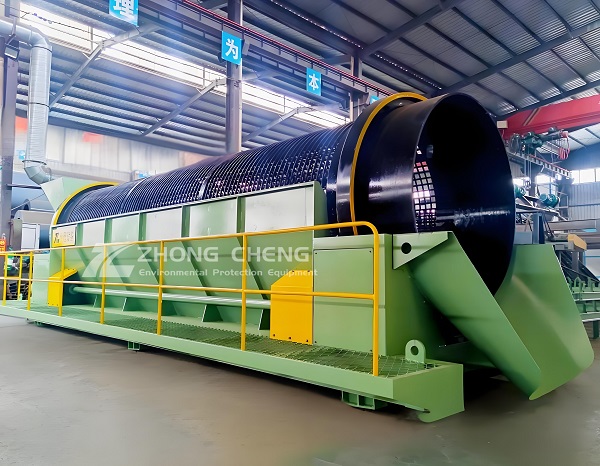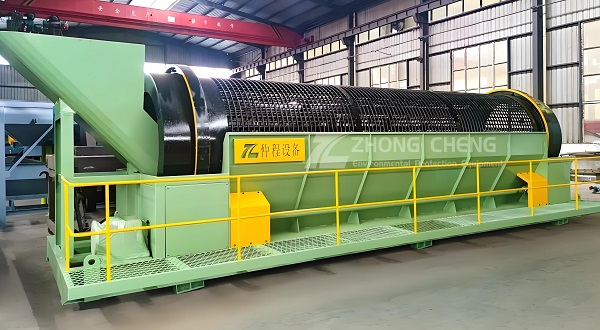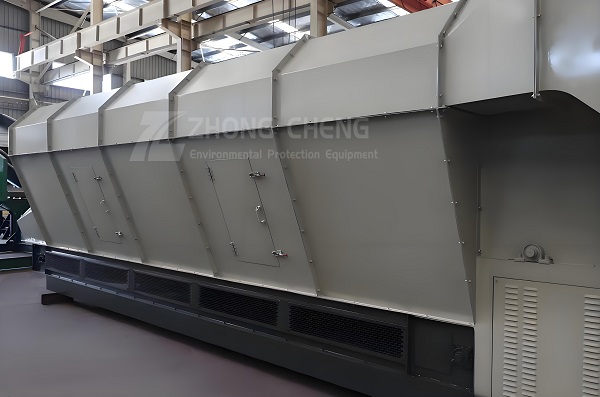Waste screening equipment is a mechanical device used for preliminary classification and separation of waste, and plays an important role in the field of waste disposal. The following is a detailed introduction to waste screening equipment:
A. Working principle
waste screening equipment mainly uses screening technology to separate waste based on its physical properties (such as particle size, density, shape, etc.). The equipment uses a variety of technical means such as mechanical screening, wind separation, magnetic separation, and optical recognition to achieve accurate classification of waste.

Waste screening equipment trommel screen
B. Common types and characteristics
1. Automatic sorting system: Combining image recognition technology and artificial intelligence technology, it can quickly and accurately identify recyclable materials in waste, such as plastics, paper, metals, and glass, and automatically sort them out through mechanical arms or airflow. This system not only improves sorting efficiency, but also greatly reduces the burden of manual operation.
2. Optical sorting equipment: It uses the difference in reflectivity of different materials to light for identification and sorting. It can distinguish recyclables such as glass, plastics, and metals, and is particularly suitable for sorting materials with obvious color or material differences, with the characteristics of high efficiency and accuracy.
3. Magnetic separator: Use a strong magnetic field to adsorb and separate ferromagnetic metals in the material. When the waste passes through the magnetic separator, the magnetic metals such as iron and steel in it will be attracted and separated by the strong magnetic field. This equipment has a simple structure, easy operation, and high separation efficiency, and is widely used in various waste disposal scenarios.
4. Eddy current sorting equipment: Mainly used to separate non-ferrous metals such as aluminum and copper. When these metals pass through a high-speed rotating magnetic field, eddy currents will be generated, and then they will be thrown away from the waste flow by the magnetic field to achieve sorting. This equipment has the advantages of large processing capacity and high sorting efficiency.
5. Wind separator: Use aerodynamic principles to sort according to differences in material density and shape. It can generate strong wind force to separate light materials (such as plastics and paper) from heavy materials (such as stones and glass). The wind separator has the characteristics of low power, low noise and large processing capacity.
6. Vibration screening machine: Use the vibration principle to screen the particle size of waste and separate materials of different sizes. At the same time, the equipment also has the advantages of simple structure, easy maintenance and large processing capacity.
7. Drum screen: A screening device that grades materials according to their particle size. It adopts a fully sealed structure and is equipped with a dust removal and deodorization system, which does not raise dust or pollute the environment. The screen plate of the drum screen keeps rotating forward, so that the material is continuously screened during transportation. This equipment has a large processing capacity, high sorting degree, is not easy to clog and has low energy consumption.
8. Bar sorting screen: It is particularly suitable for separating materials before waste sorting. The equipment adopts a bar vibrating screen structure, and the vibrating motor generates an exciting force to vibrate the screen surface, thereby separating large impurities and non-recyclable materials in the material. The bar sorting screen has the advantages of simple structure, easy maintenance, high output and long life.
C. Application scenarios

Waste screening equipment trommel screen
1. Urban domestic waste treatment center: Screening equipment is one of the core facilities. Through a series of automated processes (such as magnetic separation, wind sorting, screening, etc.), mixed waste is separated into recyclables, organic waste, hazardous waste and other categories to improve waste treatment efficiency and resource recycling rate.
2. Environmental sanitation: widely used in waste disposal in public places such as urban streets, parks, and squares. For example, mobile waste screening vehicles can quickly screen waste on site, improve the efficiency of waste disposal and the accuracy of classification.
3. Resource recycling: high-energy screening of various types of waste, separation of recyclable materials such as metals, plastics, and paper, etc., to provide high-quality raw materials for the resource recycling industry.
4. Waste incineration power plant: screening equipment can reasonably separate combustibles in waste, improve incineration efficiency, and reduce pollutant emissions. At the same time, it can also separate organic and inorganic matter, providing the possibility of resource utilization of waste.
D. Purchase suggestions

Waste screening equipment wind sifter
1. Clear demand: First, clarify the basic requirements such as processing volume, waste type, and site restrictions, which is the basis for selecting equipment models.
2. Evaluate technical parameters: Compare the screening efficiency, sorting accuracy, energy consumption indicators, etc. of different equipment, and choose products with high cost performance.
3. Investigate the strength of suppliers: Choose manufacturers with good reputation, strong technical support capabilities, and perfect after-sales service to ensure stable supply and after-sales service of equipment.
4. On-site trial and case reference: If conditions permit, conduct on-site trials or inspect applied examples to intuitively understand the actual performance of the equipment.
5. Consider future development: Choose equipment with upgradeable and modular design so that technology can be upgraded or expanded in the future according to changes in demand.
PS: waste screening equipment has broad application prospects and important value in the field of waste disposal. With the continuous advancement of technology and the improvement of social environmental awareness, these devices will continue to be optimized and improved, making greater contributions to sustainable social development and resource recycling.
Save Time! Get A Detailed Quotation Quickly.
